Juiced
If life in exile means the return of the Georgetown Dynasty, it's a good thing I like dumplings.
Syracuse: 53
Georgetown: 68
The travels, trials, and tribulations of The Bill in China
If life in exile means the return of the Georgetown Dynasty, it's a good thing I like dumplings.
I got another suit made this week, and at the same time a traditional Chinese silk coat; they kind with the big sleeves and knotted buttons. Its black with with cuffs, no frilly designs. It looks badass.
The past two or three days have been exceptionally warm, but yet we've also had snow. It's quite odd. But at the same time, obvious that the groundhog (do they have groundhogs in China? I dunno.) didn't see his shadow.
The last entry on this, the blog of blogs, commented on the lack of good humor in the Chinese language.
We need to recognize that we live in a world of many cultures and many languages, and certain aspects will never translate well from one to the next. Fine. This might manifest itself most commonly within humor. Now, I'm at the point now where I can watch a movie in Chinese and understand most of it, and if its got comedy then I can usually swing with it. This isn't much of a feat, as most Chinese comedies seem to ceiling at slapstick.
Whoa. That sucked. My internet's been shut off for maybe 3+ days now and I've been driven to the brink of insanity. Happy to see that in that time we here at Immigrant Songs have garnished a bit of respect. One compatriot (the AeroPerro) gave a nod on his own blog (http://dog.aereoperro.com/), which is pretty much the only blog I can read from China.

Today's the day: one year since I set foot back in China. February 14 will from this point forward will mark the completion of my first complete year abroad, my first year truly staking it out on my own, my first big test in a long time. Guaranteed not to be my last.








Tonight, February 12, brings the Lantern Festival and with that the end of Spring Festival. Beginning tomorrow morning firecrackers and fireworks will once again be illegal until next year.

 It took a bit of wandering but we eventually got to the Temple. I was happy to find my temple-philia had returned and enjoyed myself thoroughly wandering this this Daoist shrine. The stone was all a very darky carved bit of rock, well warn in parts by those hoping for good luck. Each of the individual rooms held different altars, which you aren't allowed to photograph, but each depicting a seperate Daoist deity. My favorite held the founding god flanked by the eight immortals, four on each side. But in front of the founding god stood two cylindrical cones of light. Pretty, shiny things mesmerize me, and thus sat and stared for a while.
It took a bit of wandering but we eventually got to the Temple. I was happy to find my temple-philia had returned and enjoyed myself thoroughly wandering this this Daoist shrine. The stone was all a very darky carved bit of rock, well warn in parts by those hoping for good luck. Each of the individual rooms held different altars, which you aren't allowed to photograph, but each depicting a seperate Daoist deity. My favorite held the founding god flanked by the eight immortals, four on each side. But in front of the founding god stood two cylindrical cones of light. Pretty, shiny things mesmerize me, and thus sat and stared for a while. 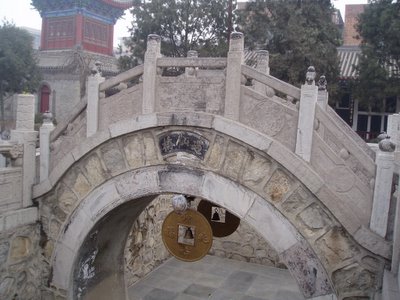

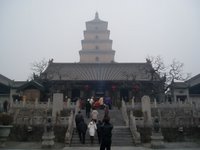 Xuan Zang, the monk-hero of "Journey to the West" and the man responsible for bringing a cavalcade of Buddhist scriptures from India back to China, only then to spend years upon years translating them. His journey began in Xi'An, and ended back here in Xi'An, right here at the Big Goose Pagoda. This is where XuanZang sequestered himself till his death, working all the while at his books.
Xuan Zang, the monk-hero of "Journey to the West" and the man responsible for bringing a cavalcade of Buddhist scriptures from India back to China, only then to spend years upon years translating them. His journey began in Xi'An, and ended back here in Xi'An, right here at the Big Goose Pagoda. This is where XuanZang sequestered himself till his death, working all the while at his books.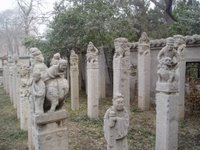 We climbed the pagoda, seven stories up and nothing after Hua Shan hike. At the top we got a real beautiful outlook on the fog. Wow. Not sure if winter is always like that there, but wow. That was a lot of fog we saw. Plans for coffee were made as we headed back out and through this Tiananmen-sized shopping ring: huge multi-storied visitor centers and KFCs, that sort of thing. But first the Little Goose Pagoda.
We climbed the pagoda, seven stories up and nothing after Hua Shan hike. At the top we got a real beautiful outlook on the fog. Wow. Not sure if winter is always like that there, but wow. That was a lot of fog we saw. Plans for coffee were made as we headed back out and through this Tiananmen-sized shopping ring: huge multi-storied visitor centers and KFCs, that sort of thing. But first the Little Goose Pagoda. 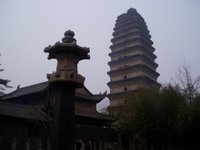 The Little Goose is under renovation, and the gardens are kinda dismantled for winter, so this somehow gave the place a spooky feeling at time. Especially with the fog. A few funny signs, though, which I'll post up later.
The Little Goose is under renovation, and the gardens are kinda dismantled for winter, so this somehow gave the place a spooky feeling at time. Especially with the fog. A few funny signs, though, which I'll post up later.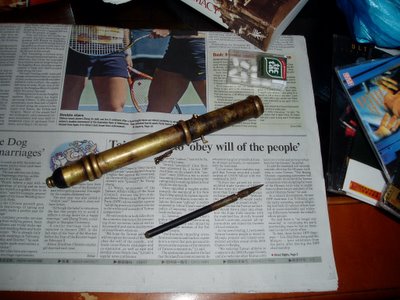
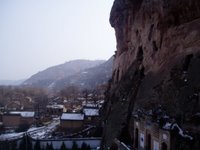
 But being a Buddha-holic, a strong calling attracted me to a 3-hour bus ride out into this wide-open wilderness. We spent the morning driving across flat, low-growth orchards of some sort of barby fruit tree (never got a good guess as to what it was) eventually to snake up and through mountains. These werent as epic as Hua Shan, but seemed more like mud pies left behind by a world-shaping toddler. In fact, I wouldn't give much emphasis to the views of the rising mountains so much as the incredible gorges that sheared through them. These drops would open up out of no where and amaze the crap out of me. I'm no geologist, but after seeing an uncountable number of small caves dug into these mountainsides (for storage, religious meditation, and habitation) it was easy to conclude that the rock was not a hardy one and prone to such manipulation.
But being a Buddha-holic, a strong calling attracted me to a 3-hour bus ride out into this wide-open wilderness. We spent the morning driving across flat, low-growth orchards of some sort of barby fruit tree (never got a good guess as to what it was) eventually to snake up and through mountains. These werent as epic as Hua Shan, but seemed more like mud pies left behind by a world-shaping toddler. In fact, I wouldn't give much emphasis to the views of the rising mountains so much as the incredible gorges that sheared through them. These drops would open up out of no where and amaze the crap out of me. I'm no geologist, but after seeing an uncountable number of small caves dug into these mountainsides (for storage, religious meditation, and habitation) it was easy to conclude that the rock was not a hardy one and prone to such manipulation. As we keep bringing up Indian Jones towards this vacation, I'll do it again: this temple, carved into the side of a mountain, was reminiscent of the Grail Temple in "Last Crusade," but of course Asianed-out Surrounding it was a small village and more small caves. The temple itself was rather straight forward, or so it seemed, but as we explored we found many grottoes that required one to climb up via rusty chain or sneak behind altars. Some of the more interesting bits were locked off; namely a grotto containing hundreds of "arhats," which might be like apostles of the Buddha (NOT boddhivastras/boddhisatvas [SP?]). Fun to clamor about and poke around, especially since once again we were the only ones there.
As we keep bringing up Indian Jones towards this vacation, I'll do it again: this temple, carved into the side of a mountain, was reminiscent of the Grail Temple in "Last Crusade," but of course Asianed-out Surrounding it was a small village and more small caves. The temple itself was rather straight forward, or so it seemed, but as we explored we found many grottoes that required one to climb up via rusty chain or sneak behind altars. Some of the more interesting bits were locked off; namely a grotto containing hundreds of "arhats," which might be like apostles of the Buddha (NOT boddhivastras/boddhisatvas [SP?]). Fun to clamor about and poke around, especially since once again we were the only ones there. The big draw, and I do mean big, awaited within the center chamber of the temple. Standing 30 meters tall (approx 100 feet) and sitting in the center of the room facing out away from the mountain: one big Buddha. Big. I've never seen one so big. Obviously touched up to maintain its appearance over the years, the skin sparkeled gold, the hair blue, big-ol'-kissable-Buddha-lips red. To the sides: an 18 meter statue of GuanYin (China's favorite Buddha) and some other Buddha. Seeing the two flanking statues leaning in towards the center of the chamber sent an immediate desire to jump upon one of their heads only to push it over, crashing through the wall, thus bringing myself and Marion to safety.
The big draw, and I do mean big, awaited within the center chamber of the temple. Standing 30 meters tall (approx 100 feet) and sitting in the center of the room facing out away from the mountain: one big Buddha. Big. I've never seen one so big. Obviously touched up to maintain its appearance over the years, the skin sparkeled gold, the hair blue, big-ol'-kissable-Buddha-lips red. To the sides: an 18 meter statue of GuanYin (China's favorite Buddha) and some other Buddha. Seeing the two flanking statues leaning in towards the center of the chamber sent an immediate desire to jump upon one of their heads only to push it over, crashing through the wall, thus bringing myself and Marion to safety. We took in the temple for about an hour, then headed back to the bus stop for the 3 hour ride back to Xi'An. An easy day, finished with a delectable multi-course meal at a moderately fancy restaurant. One dish, some sort of stringy bread dealie-do, tasted so good I shivered. Lots of cashews too, and thats never a bad thing. I think we could all benefit from using cashews more often in our cooking. But I've always know this, ever since I was young and my father would scold any young Bill caught simply picking out the cashews alone from his tins of mixed nuts.
We took in the temple for about an hour, then headed back to the bus stop for the 3 hour ride back to Xi'An. An easy day, finished with a delectable multi-course meal at a moderately fancy restaurant. One dish, some sort of stringy bread dealie-do, tasted so good I shivered. Lots of cashews too, and thats never a bad thing. I think we could all benefit from using cashews more often in our cooking. But I've always know this, ever since I was young and my father would scold any young Bill caught simply picking out the cashews alone from his tins of mixed nuts.
 Ah, the new year. At least the new Chinese year. Fresh in the heat of the dog, the time had come to leave the comforts of Xi'An and undertake the most physically rigorous leg of the vacation: scaling Hua Shan.
Ah, the new year. At least the new Chinese year. Fresh in the heat of the dog, the time had come to leave the comforts of Xi'An and undertake the most physically rigorous leg of the vacation: scaling Hua Shan.
 After being stared at during a bus ride and through a smal village, we entered the Jade Fountain Temple, open to the public for free for the holiday. This place, a rather run of the mill Daoist temple, simply swarmed with those taking advantage of the free entrance fee. Once we moved beyond it, and the ticket price jumped to 50 RMB, well, we were pretty much alone.
After being stared at during a bus ride and through a smal village, we entered the Jade Fountain Temple, open to the public for free for the holiday. This place, a rather run of the mill Daoist temple, simply swarmed with those taking advantage of the free entrance fee. Once we moved beyond it, and the ticket price jumped to 50 RMB, well, we were pretty much alone.  The climb started easy enough: as with all other Chinese mountains, they've prepped to accomodate a ridiculous mass of people at any one time and thus have lain a walkway/stairway to handle all the traffic. On this particular day, traffic topped around 7, which we'll get to later. But the mountain itself, right from the beginning, offered majestic and drastic cuts of rock face on all sides. Still hovering around freezing, many small waterfalls had become tumbling ice flows. The fog was still in full force, however, so we were unfortunately robbed of certain vistas. All the pity, but what are you gonna do? In fact, I actually kinda liked the fogged out heights, as it left what lay beyond to my imagination. As Hua Shan is not the holiest mountain of China, its often considered "the first," probably as it lies well within the cradle of the nation. Artists have painted an infinite number of pictures of Hua Shan with monks sitting in contemplation upon the peaks as dragons danced in the void beyond; its easy to see why that might be the case when you can't even see whats in that void beyond.
The climb started easy enough: as with all other Chinese mountains, they've prepped to accomodate a ridiculous mass of people at any one time and thus have lain a walkway/stairway to handle all the traffic. On this particular day, traffic topped around 7, which we'll get to later. But the mountain itself, right from the beginning, offered majestic and drastic cuts of rock face on all sides. Still hovering around freezing, many small waterfalls had become tumbling ice flows. The fog was still in full force, however, so we were unfortunately robbed of certain vistas. All the pity, but what are you gonna do? In fact, I actually kinda liked the fogged out heights, as it left what lay beyond to my imagination. As Hua Shan is not the holiest mountain of China, its often considered "the first," probably as it lies well within the cradle of the nation. Artists have painted an infinite number of pictures of Hua Shan with monks sitting in contemplation upon the peaks as dragons danced in the void beyond; its easy to see why that might be the case when you can't even see whats in that void beyond.
 Now, as mentioned, the mountain was pretty empty as most Chinese were home gorging on dumplings and scaring away the evil monster Nian through red banners and fireworks, but we did meet a few fellow travelers on our climb up. 4 were from GuangDong, in the south of China: 2 young women and their boyfriends. The girls were English teachers, one for tykes and one in a university, which was great as we taught each other back and forth as we climb. One of the guys was a professional photographer and a weathered mountain hiker, the other shared the same name with a hero from "Romance of the Three Kingdoms," another Chinese classic. I actually mentioned this as he introduced himself and it blew all the Chinese away. For some reason Chinese can't fathom why any foreigner would ever have any interest in their culture/history. (While I am working my way through that book, I didn't tell them I was first introduced to the story thanks to a fantastic old-school 8-bit Nintendo game.) The last traveler was a middle aged man who also has climbed many a Chinese mountain. He spoke no English, and we would become roommates later in the evening, but he gave me a lot of advice towards visiting China's most scenic natural wonders. All together, foreigner blokes included, we number seven, and agreed to stick together to negotiate the cheapest possible hotel rate once we reached the summit. It was a fellowship. This correllation ws beaten to death by the time we eventually headed back to Xi'An.
Now, as mentioned, the mountain was pretty empty as most Chinese were home gorging on dumplings and scaring away the evil monster Nian through red banners and fireworks, but we did meet a few fellow travelers on our climb up. 4 were from GuangDong, in the south of China: 2 young women and their boyfriends. The girls were English teachers, one for tykes and one in a university, which was great as we taught each other back and forth as we climb. One of the guys was a professional photographer and a weathered mountain hiker, the other shared the same name with a hero from "Romance of the Three Kingdoms," another Chinese classic. I actually mentioned this as he introduced himself and it blew all the Chinese away. For some reason Chinese can't fathom why any foreigner would ever have any interest in their culture/history. (While I am working my way through that book, I didn't tell them I was first introduced to the story thanks to a fantastic old-school 8-bit Nintendo game.) The last traveler was a middle aged man who also has climbed many a Chinese mountain. He spoke no English, and we would become roommates later in the evening, but he gave me a lot of advice towards visiting China's most scenic natural wonders. All together, foreigner blokes included, we number seven, and agreed to stick together to negotiate the cheapest possible hotel rate once we reached the summit. It was a fellowship. This correllation ws beaten to death by the time we eventually headed back to Xi'An. Now the climb itself was a bit harrowing at times. As mentioned, Hua Shan is steep, and at a few instances we were pulling ourselves up by chains or risking plummets that most certainly would end in nothing but death. From the base we kept hiking up and up, only taking a considerable rest to warm up with some "douzhou" or bean drink of some sort which is a bit like milk but not. A few stretches were incredibly narrow, forcing me to guffaw in disbelief that anyone would get anywhere on this mountain during peak travel times. But through cave and cliff, the North Peak was eventually reached. From there it was the East Peak and a night's rest.
Now the climb itself was a bit harrowing at times. As mentioned, Hua Shan is steep, and at a few instances we were pulling ourselves up by chains or risking plummets that most certainly would end in nothing but death. From the base we kept hiking up and up, only taking a considerable rest to warm up with some "douzhou" or bean drink of some sort which is a bit like milk but not. A few stretches were incredibly narrow, forcing me to guffaw in disbelief that anyone would get anywhere on this mountain during peak travel times. But through cave and cliff, the North Peak was eventually reached. From there it was the East Peak and a night's rest.
 Waking up the next morning the fog decided that no sunrise would be seen, but by 8 AM one could see far enough to take in the surrounding peaks and mountains. Quite majestic, as the fog and cloud still drifted in and out of the ravines; and, even more so, it had snowed during the night and so everything was a pristine and delicate white. I might go so far as to say I've never seen anything so gorgeous.
Waking up the next morning the fog decided that no sunrise would be seen, but by 8 AM one could see far enough to take in the surrounding peaks and mountains. Quite majestic, as the fog and cloud still drifted in and out of the ravines; and, even more so, it had snowed during the night and so everything was a pristine and delicate white. I might go so far as to say I've never seen anything so gorgeous. Once we set out we hiked around to the other peaks, foregoing only the West Peak, only accessible by a 500 foot walkway barely wide enough for two people, frozen over, and lacking a protectionary chain on one side. Heading back down I got stopped by many more Chinese than we had seen the previous day, all asking the same questions: "Do you speak Chinese?' "Is it safe to continue?" Due to the snowfall most of the steps had a dangerous layer of black ice acorss their tops (hence chickening out of the Western Peak) so their questions were certianly validated. My companion had had enough of the climb by this point though, so we cheated and took a gondola down and made our way back through the village to a bus and back to Xi'An. Another day done, and another unforgettable China experience.
Once we set out we hiked around to the other peaks, foregoing only the West Peak, only accessible by a 500 foot walkway barely wide enough for two people, frozen over, and lacking a protectionary chain on one side. Heading back down I got stopped by many more Chinese than we had seen the previous day, all asking the same questions: "Do you speak Chinese?' "Is it safe to continue?" Due to the snowfall most of the steps had a dangerous layer of black ice acorss their tops (hence chickening out of the Western Peak) so their questions were certianly validated. My companion had had enough of the climb by this point though, so we cheated and took a gondola down and made our way back through the village to a bus and back to Xi'An. Another day done, and another unforgettable China experience.
Saturday, the equivalent of New Year's Eve, we jumped on a bus and headed out to tour the sites east of Xi'An. Joining us was a pair of Spaniards, father and son, and some Chinese. The bus had two guides, one who spoke English just for us, but I spent as much time as I could practicing my Chinese with him.
 Anywho, first stop was the museum that purchased the first terra-cotta warriors. The story goes that in 1974, while digging a well, four farmers struck clay gold and pulled up four life-sized figures. Not knowing what the statues were, the farmers dragged them down the road to a local museum that purchased all four warriors for 28RMB (about $4). From there, its recent history.
Anywho, first stop was the museum that purchased the first terra-cotta warriors. The story goes that in 1974, while digging a well, four farmers struck clay gold and pulled up four life-sized figures. Not knowing what the statues were, the farmers dragged them down the road to a local museum that purchased all four warriors for 28RMB (about $4). From there, its recent history. Next up was a small mountain, notable for two military coups:
Next up was a small mountain, notable for two military coups: 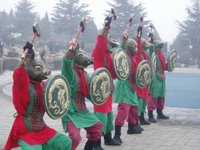 After the reconstruction, we visited the actual tomb. As mentioned, its nothing more than a big hill now, but we did get to take in a ceremonial offering to the big guy, including a dance of the 12 animals of the Chinese Zodiac. (Go monkey!)
After the reconstruction, we visited the actual tomb. As mentioned, its nothing more than a big hill now, but we did get to take in a ceremonial offering to the big guy, including a dance of the 12 animals of the Chinese Zodiac. (Go monkey!)  Then came the pits. Wow. I can't describe just how huge these things are. As it stands, there are only 3 digs open and many more untouched. Pit 1 is the largest, and its one of the largest single rooms I've ever been in. The ranks of soldiers go on and on and on, and the vast majority is still under the earth! The first pit, the largest again, holds mostly common rank and file soldiers, foot soldiers, maybe a few chariots. Pit 2 gives us more leadership, generals and such, distinguished by their taller stature. Pit 3 has even more chariots and a good amount of archers.
Then came the pits. Wow. I can't describe just how huge these things are. As it stands, there are only 3 digs open and many more untouched. Pit 1 is the largest, and its one of the largest single rooms I've ever been in. The ranks of soldiers go on and on and on, and the vast majority is still under the earth! The first pit, the largest again, holds mostly common rank and file soldiers, foot soldiers, maybe a few chariots. Pit 2 gives us more leadership, generals and such, distinguished by their taller stature. Pit 3 has even more chariots and a good amount of archers. Now apparently these warriors all had been painted, and when first unearthed still retained thier color for about three days before detriorating. Also, not a single warrior has been unearthed complete, and the archaeologists have not always been spot-on in rebuilding them. If you pay attention, you'll find warriors with two left hands, mismatched limbs, and chariot drivers sitting in the back seat of their chariots. All the more reason why the Chinese are holding off on any future excavation until technology develops.
Now apparently these warriors all had been painted, and when first unearthed still retained thier color for about three days before detriorating. Also, not a single warrior has been unearthed complete, and the archaeologists have not always been spot-on in rebuilding them. If you pay attention, you'll find warriors with two left hands, mismatched limbs, and chariot drivers sitting in the back seat of their chariots. All the more reason why the Chinese are holding off on any future excavation until technology develops.